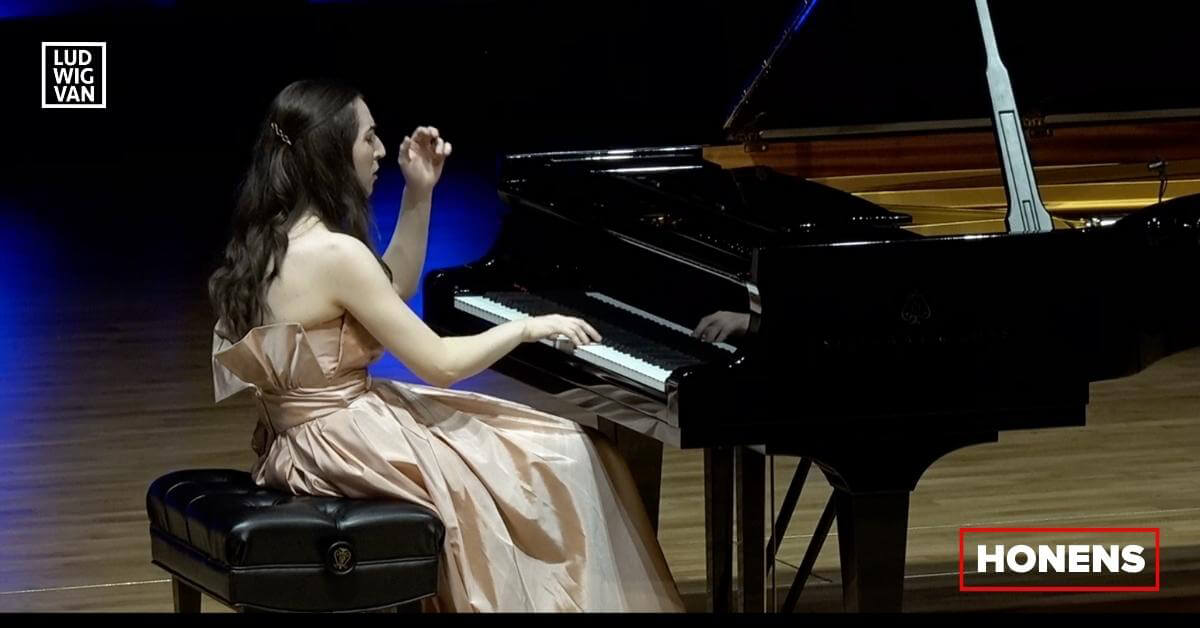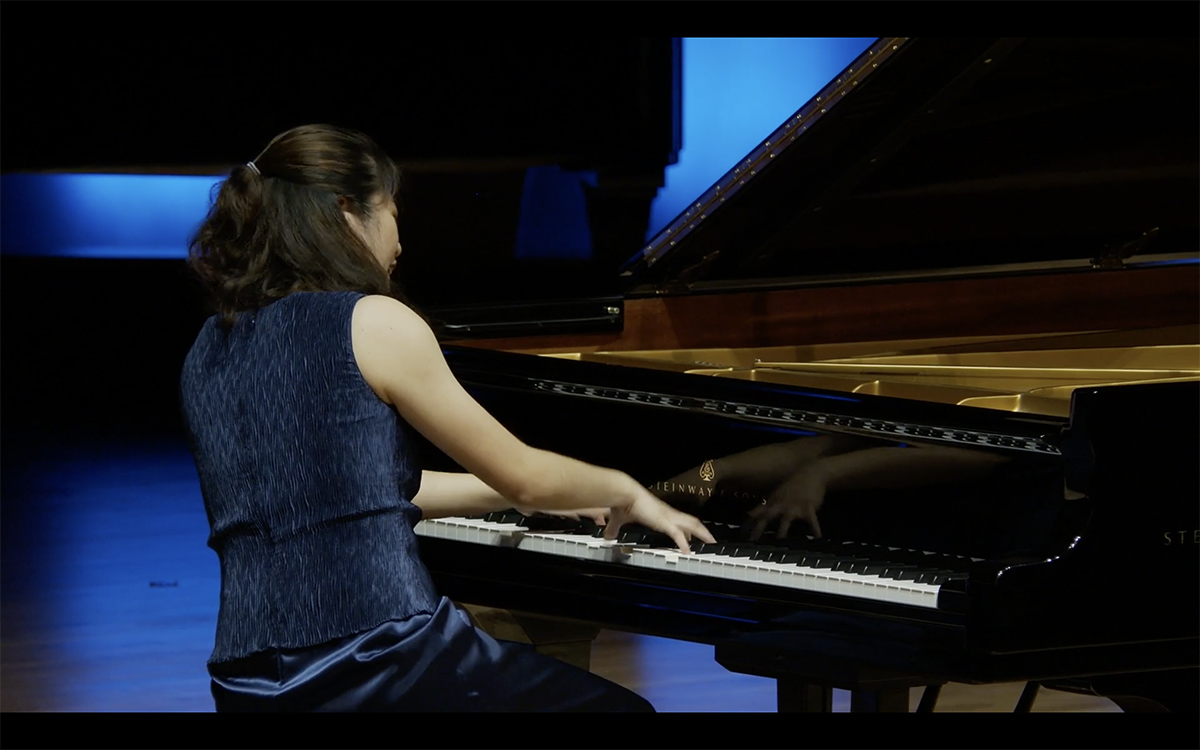
Semis I-II
CALGARY — The 10th Honens International Piano Competition, covid-complications edition, started appropriately: I watched the livestream at 20,000ft with an Air Canada “bread” in one hand. The quarterfinals earlier this year also had jurors at a distance, watching videos shot in a sound studio to boil fifty competitors down to the ten now performing in Calgary.
Each pianist plays twice in the semis. First a 65-minute solo recital that has to include a newly commissioned work by Stewart Goodyear, and then a 60-minute chamber concert with one of Beethoven’s ten violin sonatas, a piece from Fritz Kreisler’s Alt-Wiener Tanzweisen, and a bonbon they get to choose for themselves.
That’s over two hours from each pianist and this being a competition they all badly want to win, the rep leans to romantic showstoppers. Listening to all of it is the musical equivalent of competitive eating, so strap on your nosebag and let’s get force-fed some oats notes.
First up, Simon Karakulidi, who started sweetly with Valentin Silvestrov’s Allegretto from 3 Bagatelles Op. 1 (2005), a hopeful, even naive-seeming piece by a Ukrainian composer who is currently a refugee in Berlin. This was a red herring. The Beethoven (vampy), Liszt (mechanical), and Goodyear (brash) that followed revealed a different performer: huge expressive potential — and upper body strength! — but enervated, like he was struggling to ride whatever brutal spirit possessed him at the keys.
Łukasz Byrdy was a fine contrast, all shading and analytical precision. He started with the Goodyear and found surprises in the Rondo Capriccioso’s fireworks (seen those videos where a barge loaded with a 20-minute fireworks show goes off all at once? It’s like that.) His rendition of Szymanowski’s Masques was a Bermuda triangle of intellectual subtleties—I thought we might lose Byrdy in there—but he found warmth in Chopin in Etude in C-sharp minor Op. 25 No. 7 and ended with an elegantly oiled Brahms Piano Sonata No. 3. The Scherzo was decadent. I was shocked, amidst so many perfectly-placed notes, to remember Karakulidi’s wildness with new pleasure.

The evening round began with Angie Zhang and a revelatory performance of Mily Balakirev’s Piano Sonata in B-flat minor (1905). This late 19c Russian was one of the nationalistic establishment group “The Five” with Borodin, Cui, Mussorgsky, and Rimsky-Korsakov; and he was against formal training, bless him. Zhang’s meticulousness is remarkably balanced with feeling, a capacity she applied to the Goodyear with intriguing results. For the first time in the semis I could shrug off the structural virtuosity of the work—useful in a competition, you need see them sweat — and start to dream, and the Rondo became a dance of porcelain automatons. Like something a child magician spies through a keyhole and backs away from. She finished with a lightweight (bordering on malnourished) Sonata No. 3 by Chopin, but it is fun basking in apparent effortlessness. I could see her in the finals.
Last on Thursday night was Rachel Breen, who started with another under-appreciated 19c Russian, Micolai Medtner. He’s known for abandoning a virtuoso performance career—I wouldn’t want to compete with Rachmaninoff either—to turn to composition, and for marrying his brother’s wife. Amidst so many stiff and eager young “professionals”, Breen radiates a natural pleasure at the instrument. I’m tempted to explain it by her (relatively) late start after years playing for herself. Her program had more personality than the average, too. She treated Medtner’s Piano Sonata No. 3 in G minor Op. 22 a bit casually, the Goodyear lacked confidence but she brought out inner voices and pivots that I hadn’t heard yet, which is explained by her affinity for Bach. She finished with a mesmerizing performance of the Goldberg Variations, peppered with idiosyncratic interpretations of volume and tempi. Her performance of the 25th variation haunted me for a day. Will she make the finals? It depends what Honens means by “the complete pianist.” But one to watch, regardless.
Semis III-IV
It is a relief to listen in the room rather than hurtling through the air looking over your shoulder to see if the flight attendants have noticed you’ve tricked their wifi into letting you watch forbidden video streams. I don’t recommend looking around Mount Royal University’s campus while you walk to the Bella Taylor hall, though—nobody comes to Calgary for the urbanism. The dark thoughts persisted after the grim walk from the parkade and I noticed with alarm how the previous winner, Nicolas Namoradze, seems to be everywhere at this year’s competition. What’s the true price of victory? Is he even allowed to leave this place? I thought about pulling up his pant leg to check for an ankle bracelet. Nicolas, blink three times if you need a ride. (Happily, the hall itself is an auburn tea box; a modest design of veneered curves that most importantly sounds warm and clean.)
The afternoon concert began with Sae Yoon Chon, who started studying violin but preferred an instrument where he “could sit down”. His performance was heavy-handed and heavy-footed, from an uneven Brahms Piano Sonata No. 3—missing details, squeezing the theme of the Finale to the edge of perception, but also flourished with superhuman speed and accuracy — to an exciting but reckless Goodyear, which reminded me of this fake video of a stressful bus ride. His Prokofiev was best. Sinister and elegant like bumping into Tilda Swinton at your local bar and noticing there’s a trickle of blood running from the corner of her mouth. His pyrotechnics singed very little in the first movement and by the third there was a deliciously unsettling sense that the forces onstage were barely contained. Will it be enough? (The moment he’d finished, an elegant older lady dashed through the aisle, probably to buy a refreshing tallboy at the dedicated beer bar, and woofed “Thank you, Prokofiev!”)
Philipp Scheucher is one of the oldest competitors at 29 and his program was only the second, after Breen, to feel thoughtfully constructed rather than the musical equivalent of greased bodybuilders flexing under arc lights. The credit isn’t his alone, it’s composer Gerd Kühr who wrote two Intermezzi (2014) for Schubert’s 3 Klavierstücke. This is a very tasty club sandwich. The alien tang of Kühr’s interventions sits next to Schubert’s lyricism like a beautiful hallucination. I imagined playing Schubert into an empty sewer pipe and hearing a faint echo from the other end; unfamiliar and frightening, and clearly made by something intelligent. It is hard to identify Scheucher’s limitations, yet. His performance of Goodyear was weightless, the first pianist to sound like they’d solved its puzzles, and the Schumann Symphonic Etudes were simply brilliant–meditative. It was even difficult to think. It will be a surprise if he doesn’t make the finals.
The evening semis began with Ádám Balogh who — and I mean this as a compliment — seems to be part squid. There is a smoothness and slipperyness to his fingers (has anyone checked if he has the usual number?) and a capacity for astonishing delicacy that is positively aquatic. He opened with Bartók’s Improvisations on Hungarian Peasant Songs Op. 20, bringing out their mischievous restlessness to delightful effect. His daintiness sometimes becomes hesitancy, particularly in the pedal that intruded a few times. Gaspard de la Nuit suits him perfectly but I’m physically incapable of appreciating Ravel’s vapid noodling. I was more concerned about what the Goodyear would do to this gentle person. It dragged him onto the beach, grilled him and ate him. And finally, between beautiful moments and sprays of shocking detail, the Rachmaninoff needed more brawn.
Friday night ended with 21-year-old Illia Ovcharenko, the youngest semifinalist, in an athletic mood. He somehow managed to quicken my pulse with an eighth performance of the Goodyear, delivered with gloss and power. Beethoven’s “Les Adieux” may seem like too safe a choice for this week’s knife fight but Ovcharenko blitzed through it wherever he could, without losing his distinctive bell-like tone. The overall impression was of an artist with a coltish impulse to find out how fast he can really run. But he seems too clever to lose control, so Schumann’s Kreisleriana included breakneck stunting as well as coy affection.
Though, by this point, he was facing growing competition from the audience’s panicked spinal columns. It wasn’t entirely Ovcharenko’s fault, he only went a few minutes over his 65, but it seems that none of the previous competitors had prepared us for what a full use of their time would feel like, especially at the very end of the night. It was an enraptured performance but circumstances conspired to make it feel relentless. After the Schumann, there was still Alberto Ginastera’s Piano Sonata No. 1 Op. 22 (1952), a playful mid-century gem with quotations from what sound like electronic synths. Had we doubted that the colt also had endurance? No. Absolutely not. Please, no.
Over a breakfast of muscle relaxants the next morning, it became possible to appreciate one of the most exciting performances so far.
Livestream the 10th Honens International Piano Competition [HERE].
Get the daily arts news straight to your inbox.
Sign up for the Ludwig van Daily — classical music and opera in five minutes or less HERE.
- REPORT | Ukrainian Pianist Crowned Winner Of 2022 Honens Competition - October 29, 2022
- REPORT | The 10th Honens International Piano Competition: Finals I - October 28, 2022
- REPORT | The 10th Honens International Piano Competition: Semifinals IX-X - October 25, 2022



